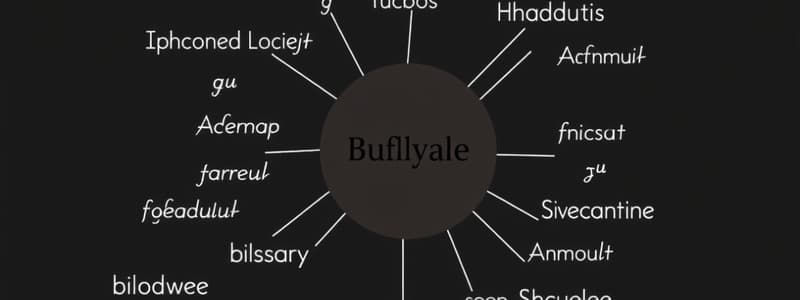Podcast
Questions and Answers
What is the study of linguistic unit of sounds called?
What is the study of linguistic unit of sounds called?
Phonetics
What is the basic unit of sounds known as?
What is the basic unit of sounds known as?
Phoneme
What method is primarily used for teaching reading and writing?
What method is primarily used for teaching reading and writing?
Phonics
What type of morpheme can stand alone as a word?
What type of morpheme can stand alone as a word?
What is the study of words and their parts called?
What is the study of words and their parts called?
What is the study of meaning in context and utterance?
What is the study of meaning in context and utterance?
What are the two components of the meaning of a word?
What are the two components of the meaning of a word?
Which of the following are considered macro skills of language?
Which of the following are considered macro skills of language?
What is the process of understanding and interpreting spoken language called?
What is the process of understanding and interpreting spoken language called?
What does visual literacy enable an individual to do?
What does visual literacy enable an individual to do?
What is the study of social life and social change called?
What is the study of social life and social change called?
What is the descriptive study of the effect of society on language called?
What is the descriptive study of the effect of society on language called?
What type of literacy involves understanding and evaluating information from visuals?
What type of literacy involves understanding and evaluating information from visuals?
Flashcards are hidden until you start studying
Study Notes
Phonetics and Phonology
- Phonetics focuses on the physical production and perception of sounds in language.
- Phonology studies how sounds function and are organized within particular languages.
- Phonemes are the smallest units of sound that can distinguish meaning.
Morphology
- Morphology examines the structure of words and their parts.
- Morphemes are the smallest meaningful units of language.
- Bound Morphemes require attachment to other morphemes (e.g., "bea-u-ti-ful").
- Free Morphemes can stand alone as words (e.g., "beautiful").
Pragmatics and Semantics
- Pragmatics studies how context influences the meaning of utterances.
- Semantics deals with the literal meanings of words and sentences.
Syntax
- Syntax refers to how sentences are structured, including the arrangement of phrases and clauses.
- Example of syntax: “John (N) kicks (V) the (A) ball (N).”
Macro Skills of Language
- Macro Skills are essential for effective communication in any language, encompassing listening, speaking, reading, writing, and viewing.
Listening
- Critical for understanding and interpreting spoken communication.
- Effective Listening Techniques include:
- Maintaining eye contact with the speaker.
- Avoiding interruptions.
- Asking clarifying questions.
- Providing feedback and focusing on non-verbal cues.
- Differentiation between Listening (comprehending and responding) and Hearing (passive reception).
Speaking
- Unique to humans and essential for clear communication.
- Involves elements such as pronunciation, stress, and intonation.
- Connotation refers to associated meanings of words, while Denotation is the literal dictionary definition.
Types of Communication
- Formal Communication follows established conventions.
- Informal Communication is casual and relaxed.
- Slang includes informal language specific to particular groups.
Types of Language Functions (Richard, 2008)
- Talk as Interaction: Focuses on social relationships.
- Talk as Transaction: Involves the exchange of information to achieve a specific goal.
- Talk as Performance: Centers on how ideas are received by an audience.
Reading
- Involves recognizing and comprehensively understanding written text.
- Important skills: decoding, fluency, vocabulary development.
- Types of reading:
- Intensive Reading: Detailed understanding with specific learning goals.
- Extensive Reading: Engaging with texts for enjoyment and general skill development.
Writing
- A cognitive activity involving structured expression of thoughts through written words.
- Steps in writing include topic selection, research, outlining, drafting, and editing.
Viewing
- Involves analyzing and comprehending visual content.
- Visual Literacy focuses on creating meaning through visual media.
- Critical Literacy entails understanding and evaluating visual compositions.
Related Fields of Study
- Sociology: Examines social life, change, and behavior's societal implications.
- Sociolinguistics: Studies how societal aspects affect language use.
- Anthropology: Investigates humanity and cultural dimensions.
- Anthropological Linguistics: Explores relationships between language and culture.
- Philosophy: Explores human existence and understanding, connected to language insights.
Studying That Suits You
Use AI to generate personalized quizzes and flashcards to suit your learning preferences.




